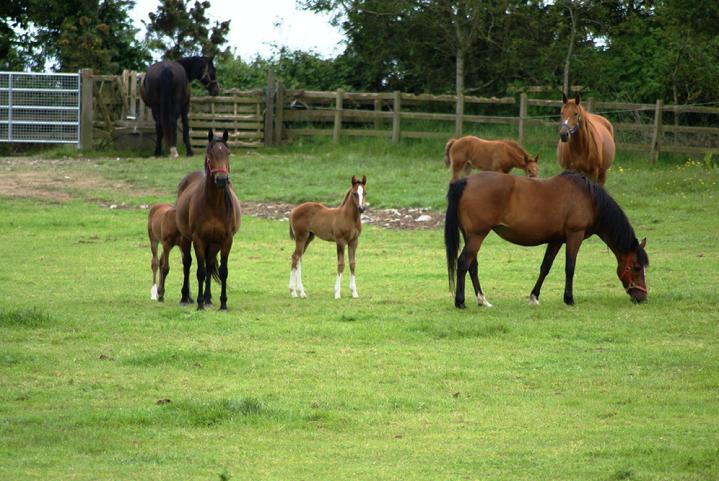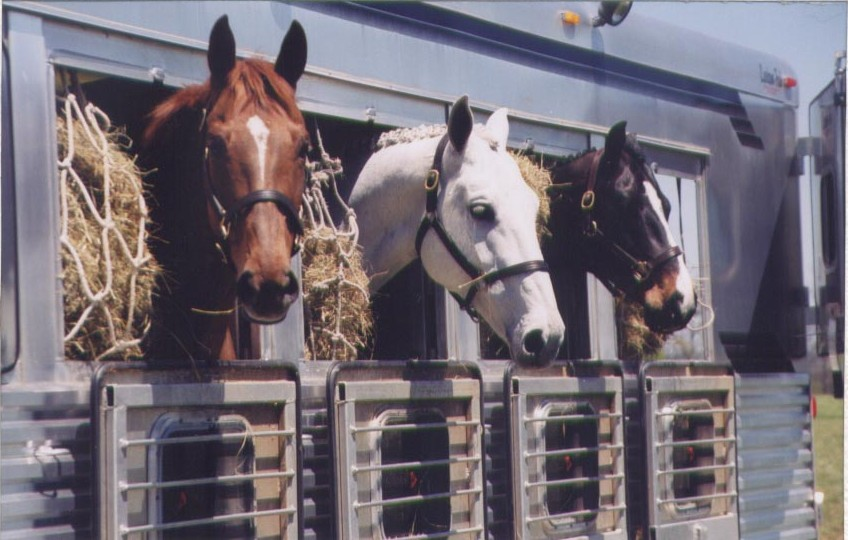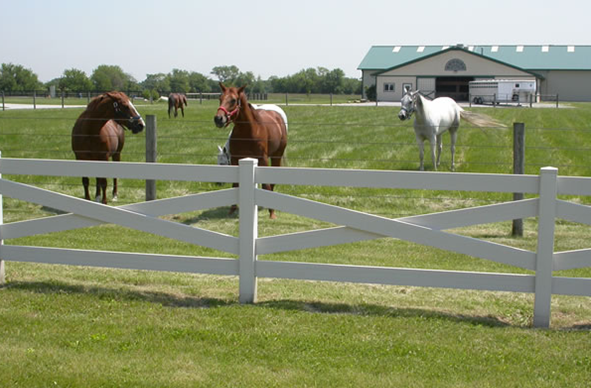Horses - Educational Resources

Horses Grazing in Pasture

Heading to the Rodeo!

Horses Behind Fence
There are a variety of educational publications to learn more about horses and/or programs within the Arkansas 4-H Horse Program as well as the Extension Horse Program. Click on the links below to access and download publications.
4-H Horse Contest Information
For information related to 4-H Horse Competitions, please visit the 4-H Plant and Animal Science page or contact your local county agent.
Additional Information
There are a variety of career paths for those interested in working in the Equine Industry. One of the best qualities of working in the Equine Industry is that fact that any person of any age can find some type of work associated within our industry. With these options, decisions should be made regarding what level of commitment one is willing to invest in a certain opportunity. For example, being a horse trainer or owning a boarding facility isn’t a 9-5 job Monday – Friday. For most folks in those occupations, it’s more than just a job or even a career; it’s a way of life and most wouldn’t trade what they do for anything. However, there are many other options for those that may not want to go into training or boarding. But no matter the occupation, one should consider following questions outlined by Dr. Rick Parker from the College of Southern Idaho:
- Are you willing to work long, hard and irregular hours – 16 hours a day, 7 days a week?
- Do you get along well and communicate effectively with people?
- Are you comfortable with problem solving and troubleshooting?
- Will you seek help when needed?
- Do you have the technical expertise to manage the operation?
- Can you afford to hire qualified help?
- Do you know others in the business that will provide help or information?
- What related associations or organizations can you join or do you need to join?
- Are you willing to learn of current practices and new development?
- Are you familiar with the legal issues of marketing your product?
- Do you have the resources to construct and operate a facility?
- Do you have the right location for the business you wish to conduct?
- Is the prospective business site located near your markets?
- Do you live close enough to the business site to visit and monitor it as needed and to ensure security?
- What utilities are available at the site of the business?
- Are the available water resources adequate?
- Can you effectively manage any waste produced by your operation?
- Will your neighbors and others accept your business operation?
- Have you discussed you planned operation with the appropriate local, state, and feral agencies?
- Have you identified the permits and insurance required to construct and operate the business?
- Do you have the resources – financial, technical, and special – needed?
- Are support services and industries available?
- Do you have access to a dependable workforce for physical labor?
The equine industry can be a very enjoyable and rewarding career path. A keen eye for business and a well laid plan cannot be overstated.
As hay supplies dwindle over the next few months and the uncertainty of feed prices continue to exist, horse prices may continue to be low for some horses. Of course, the talented horse with ability will continue to sell well, but there are always those horses that make buying a huge temptation due to their low price. Even as a veteran buyer or novice, there are some items to consider making that purchase:
- Ask for health history of the horse. Has he/she ever foundered? Has it ever coliced? What condition are his/her feet in? Are there any visible injuries or scars? When was the last time it had vaccinations and was de-wormed? Has he/she worn shoes before? What does the current owner feed?
- Ask to have the horse lunged or rode to see behavior and movement. Is the horse sound?Does it buck? Ride the horse yourself to see if you “click”. Can he/she be tied without sitting back? Can he/she be clipped? Is he/she easy to catch? Is he/she kid safe? Does he/she spook easy?
- What type of trailer is he/she used to riding in? Can he load without problem? Does he back out of the trailer?
- What is the job/event you are hoping to do with this horse?How is it bred? Will he/she need more training or only maintenance? Is the horse arena sour?
- How long has the current owner had him? Where was he/she born and can it handle the Arkansas climate? How many owners has he/she had?
- What are the possible reasons the horse is being sold?
- Does the seller have a positive reputation for selling good horses?
- What type of facility is the horse used to? Many horses have only lived in a pasture or stall. Many horses are used to a certain type of fence.
- If applicable, when was the horse gelded?
- Take a transfer of ownership form with you so that everything can be taken care of at once.
- Take someone with you who is knowledgeable and may notice something you don’t. Consult with a veterinarian and have vet checked if possible. Should also take farrier with you if possible.
One of the things that I have noticed in agriculture news lately is the unfortunate occurrence of barn fires across the country. While barn fires are probably never 100% preventable, there are some things that we can do as horse owners that may prevent this disaster, or at the very least minimize the damage and loss of horses. While doing some research in the area of barn fires, I came across some information I found valuable, yet simple enough that it could be done quickly to ensure my barn was up to date on fire prevention.
At the 2008 American Association of Equine Practitioners convention, Rebecca Gimenez, Ph.D. stated that barn fires kill more horses annually than any other type of nonmedical emergency. Of 11,500 agricultural storage facility fires per year, 88% are barns or stables with animals. This results in $250 million in property losses each year. In 87 horse-barn fires incidents reported in 2006 and 2007, 461 horses died and an unknown number were injured. Like most tragedies, I never think that it could happen to me. Thus, I don’t take near as much precaution as I should when it comes to protecting my horses in the event of a barn fire. After much research on the topic, I was able to put together as list of pre-cautions/actions horse owners can take to help prevent barn fires:
What is the evacuation plan for every horse and person from the facility? Have you laid out an evacuation plan and discussed with your family and employees? Horses are known to run back into a barn fire, so simply opening the door is not enough to ensure they will escape. A halter and lead rope should hang on each door so that it is easily accessible and can be placed on the horse and led out quickly. Stalls and barn doors should remain unlocked at all times. Stall and barn doors should also be clear of any objects that may slow down the evacuation process.
Store hay, shavings, cleaning products, and other combustibles away from the bard. These items will help the fire spread quickly and increase the temperature of the fire exponentially. Keep only a small amount in the barn and replenish as needed. If they are to be kept in the barn, cleaning products, oil, and alcohol should be kept in steel boxes.
Minimize human error. Keep “No Smoking” signs visible around and inside barn and demand that there be no smoking in the barn. Also, exercise extreme caution when using welders or cutting torches. The sparks from these items or from cigarettes are enough to ignite a fire. Vehicles should be parked away from the barn. The heat from exhaust pipes have been known to start hay stacks on fire. Furthermore, have an electrician make frequent visits to the barn to check the wiring system for aging and rodent damage. If possible, cut off electricity to the barn if no one is home or around the barn.
Keep appliances to a minimum. Avoid using space heaters or radios that are not battery operated. Overloaded circuits can lead to wires becoming hot and reaching ignition levels. Keep light bulbs caged and switches covered.
Install lightning rods at the highest point of the barn. Lightning rods on rooftop high points are connected by cables that run to ground to divert the energy of a strike away from the structure itself. Some barn owners choose not to use lightning rods, mistakenly believing that they attract lightning, but the devices simply conduct lightning that would have hit a structure anyway.
Guard against spontaneous combustions. Avoid leaving manure piles and insufficiently cured hay around the barn. Because there’s no ventilation in damp hay, the heat thrown off by the process builds until the ignition point for the drier surface hay is reached. Hay should be stored on pallets with a small amount of distance between each bale if possible. Though it increases labor and expense, keep only a limited amount of hay stored in the barn.
Install a warning system. Flame and heat detectors with electronic eyes can signal the presence of heat or flame as it is rising, and carbon monoxide detectors are valuable, too. Cheap smoke detectors aren't as useful because they are triggered by air particulates and dust to give false alerts.
Keep at least one fire extinguisher near or in the barn. Tags on fire extinguishers should be checked and contents updated at the local fire department as necessary. An extinguisher should be 10-20 pounds, minimal. Personnel should be trained in extinguisher use, as there is no time for a learning curve when a fire is doubling in size every minute.
Distance between buildings and barns. All outbuildings and barns should be a minimum of 50 feet apart from each other. The greater distance between each building, the less likely a fire can spread from one building to another.
Most horse fatalities are due to smoke inhalation; as a horse panics, rises in heart and respiratory rates increase inhalation of toxic fumes. Thus, is imperative to have the proper plans in place should there be a fire in your barn. Special thanks to Jane Seegal, Rebecca Gimenez, Ph.D, and Nancy S. Loving, DVM for their contributions to this article.
More often than not, our horses will show signs of stress. And just as often, horse owners can control the amount of stress seen in our horses. There are many indicators of stress. If stress levels stay low, chances are, the ride and overall experience will be a much positive one. Further, you will add life to your horse and allow him to be much happier and overall health will increase as well. But how do we recognize stress in our horses? Does it increase when we leave home? Chances are, the less frequent you leave home with your horse, the higher the stress level will be when you do leave. Never the less, horses can show signs of stress at home on a daily basis in some cases.
Horses that are experiencing stress may offer many signs to its owner. For example, they may appear to be frightened and/or nervous. We may see this in the form of running or in some cases they develop vices such as cribbing and stall weaving. Abnormal sweating can also signal a stressful situation for your horse. Muscle tone can also provide some clues. If the horse is tense and the muscles are contracted, it may be tying up. If the muscles are flaccid and extremely relaxed and the horse is depressed, the central nervous system may be damaged. If any of the signs are observed, a closer inspection is needed.
In order to fully recognize a horse’s change in condition, it is a good idea to keep permanent records for each horse in your care. The file should include:
- Permanent identification, birth date, and registrations
- Reproductive history, breeding dates, and foaling dates
- Weight and condition scores
- Normal temperature (T), pulse (P), and respiration (R), or TPR
- Deworming dates and products used
- Vaccination dates, diseases, and products used
- Illness dates, diagnoses, and treatments
- Injury dates and treatments
- Surgery dates and outcomes
- Allergy causes
Stress can be grouped into four different categories for horses:
- Behavioral or psychological
- Mechanical
- Metabolic
- Immunological
Behavioral Stress – horses do not see the world as we do. They have what is known as monocular vision as well as binocular vision. With the monocular vision, they are able to see to each side of their head, much better than humans. They also have binocular, which allows them to see objects in front of them. However, horses are unable to see approximately 4 ft directly in front of them. Further, horses hear much better than humans. All of these factors can be possible explanations of why they seem to spook easily and without warning on occasion.
When a horse is stressed, he may also show signs of agitation. A horse that is agitated may lay his ears back and swish his tail. This is not to be confused with a horse that is fearful. This horse will clamp its tail down, its body is tense and eyes may be wider than normal.
Horses are known to also feel less stress when around other horses. Even if a horse cannot be in the same pasture as other horses, they will feel more ease when they are able to see other horses that are in close proximity.
Mechanical Stress – stress level in horses can also increase greatly when there is some type of structural injury. Examples of this may include: lameness, local inflammation, swelling, heat, and/or pain. Checking for injury or lameness should be a part of the everyday routine for maintenance of your horse. The best time to do this is while feeding in the morning; and again at the evening feeding session.
Nutrition and Metabolic Stress – the horse’s digestive system is designed to handle frequent meals small meals. Further, when the horse is in a grazing environment, they are better able to maintain optimum health. To reduce stress, horses require that a certain proportion of the diet be roughage. Vitamin and mineral requirements must also be met but not exceeded for the stage and condition of the horse.
Three metabolic problems in horses are closely related with nutrition:
- Colic
- Laminitis
- Tying up
Immunological Stress – stress caused by disease and/or parasites can range from superficial discomfort to death. A good vaccination program is the best defense against infectious diseases. Additionally, an effective deworming program must include good management practices as well as regular use of antiparasitic drugs.
Some important guidelines include:
- Treat all horses at the same time
- Rotate clean horses to clean pastures
- Design feed and water facilities to prevent fecal contamination
- Remove manure frequently from stalls and paddocks
- Clip and harrow pastures regularly
- Consult with a veterinarian on selection and use of antiparasitic drugs
- Monitor the effectiveness of the parasite control program by checking egg counts in feces
As horse owners, we will never completely be able to keep our horses from becoming stressed. However, with routine checks and awareness, we may be able to manage it. Special thanks to Dr. Rick Parker for his contributions to this article.
For more information contact:
-
Dr. Mark Russell Associate Professor - Equine Extension University of Arkansas System Division of Agriculture Cooperative Extension Service 2301 S. University Avenue Little Rock, Arkansas 72204 Phone: (501) 671-2190 Fax: (501) 671-2185 Email: mrrussell@uada.edu
University of Arkansas: Animal Science